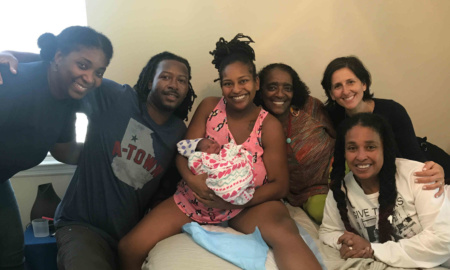
One week ago today I had the unique honor and pleasure of being the midwife at the birth of my first grandchild who was born at home. The labor, taking a day and a night, gave me ample time for reflection and contemplation on the process of birth, place of birth, and the work of being a birth attendant.
Here's the back story: My son, well, he's the child of a midwife-now family doctor who attended the home births of his 3 younger sisters and his nephew, whose birth I midwifed 20 years ago – not to mention the ones he attended on my back as an infant in a backpack. For him, home birth is a natural choice. My daughter-in-law is a Harvard pediatrics resident. This is not a trivial fact. In Massachusetts, it is the pediatricians, even more than the obstetricians, who have been the most vociferous about the dangers of midwives – they've tried to shut down birthing centers because they consider those a dangerous place to have a baby – so you can imagine the attitudes about homebirth!
When my daughter-in-law became pregnant, I shared my joy about the pregnancy, but withheld all opinions about pregnancy and birth, making it clear to her that my strongest abiding belief is that women birth best where they feel safest and if for her that is the birthing center or hospital, she had my fullest support. I let her know I was available for questions should she need any information, but I had no expectations of involvement on any level. And this was completely true and authentic.
Early in the pregnancy she opted to birth at the birthing center across the street from and affiliated with the hospital where I attend births as part of my residency program. It took a few tries for her to find the midwife with whom she felt most compatible, but she seemed pleased with her choice and settled into her prenatal care. That is, until a few weeks later when she received a report that her thyroid test was abnormal and that she might need treatment for thyroid problems, which can be dangerous for the baby if left untreated. She called me for advice and was clearly anxious and upset. Here's the problem, I told her: We really shouldn't be checking thyroid tests in early pregnancy in women who don't have thyroid disorders because pregnancy normally causes thyroid tests to come back abnormal. To reassure her of this fact, I confirmed this information via a former mentor of mine, a world-renowned expert in maternal fetal medicine. Sure enough, a few weeks later, a recheck of her thyroid test was normal. The experience left my daughter-in-law feeling less than confident in conventional prenatal testing. Strike two against conventional medical prenatal care happened later when she went through a similar misadventure regarding prenatal glucose tolerance testing. She was beginning to feel that the over-medicalization, and worse yet, mis-medicalization, of her pregnancy was a distraction from her confidence in herself – and her care providers.
At this point my daughter-in-law started reconsidering her birth options and after initially asking me if I would be her primary birth attendant at the birth center, which I couldn't do because of restrictions in place at the birthing center, she opted for a homebirth and asked me to be her midwife. Now you might think that my midwife inner self was jumping up and down with excitement over her decision; I mean, really, how cool is this! But I wasn't. While I was deeply moved and honored when she told me that I was the person she most trusted in the entire world to “deliver” my grandchild, my respect for birth is profound. I know that most of the time things go without a hitch, but it was also a big responsibility – when things go “wrong” with birth, the stakes are high.
Further, the situation for me was politically complex. I am not just a homebirth midwife with 30 years of experience with birth; I am also a medical resident whose autonomy as a doctor is not fully granted until residency completion. Thus my role at a homebirth, and especially as the midwife to a family member (and in my supervisors' eyes, doctor to a family member) is subject to the position of my program director. After all, I am covered by medical insurance provided by the program and they determine whether my conduct is considered “professional.” And on top of it all, I would also be personally and professionally judged, as would my daughter-in-law, by the pediatric and obstetric communities in which we both regularly participated, based on the outcome of the birth. Rough waters to navigate!
A further consideration I had about being the primary midwife for my daughter-in-law revolved around my experience that when push comes to shove (or should I say when birth comes to push?), a woman doesn't necessarily want her mother-in-law down by her coochie. I wanted my daughter-in-law to have an “out” clause in case she changed her mind about me being at the birth at the last minute.
We settled on bringing in another midwife to join me at the birth, to provide options should my presence at the birth not be ideal for any reason, and on some level, for political protection for me “on paper” as my program made it implicitly clear that it was not appropriate for me to take care of a family member. This is quite different than in the midwifery model, where many women have welcomed their grandchildren into the world. It is also quite different from the way medicine is practiced in small communities where the presence of only one doctor in a town or village might necessitate caring for family members. But that's another story…
Fast forward to December 18th, 2011. My daughter-in-law went into labor at 40 weeks and 3 days gestation. Labor began in earnest in the early evening, and by midnight when I called to check in before heading to sleep, I could tell by their voices on the phone that they'd feel more settled in if I came over to their place and just went to sleep there. So after 6 years of medical school and residency, I got dressed, packed my midwifery supplies into my car, and headed to my first homebirth in six years.
I never did go to sleep that night. Or until 2 am the following day. Contractions were close together and on the longer side, not allowing any rest for the laboring momma through the night. Toward morning we called my companion midwife to join us, thinking things would move fast as she was already 6 cm dilated and contractions were getting closer together and much stronger. But the day dragged on as nearly relentless labor persisted. We did all the usual things homebirth midwives do to support the natural birth process and help the mom feel comfortable, while keeping an eye on mom and baby's wellbeing. Showers, back rubs, hydration, reassurance, etc. By about 4 pm my daughter-in-law began asking for an epidural, telling us she just could not do it. In the typical birthing environment, a quick call to the anesthesiologist would have been made and mom's wish granted. To the homebirth midwife, such plaintive requests typically harken to what we call “transition” – that place when a laboring mom is about 8 cm dilated and has to be cajoled into a second wind.
Sure enough, she was 8 cm and hung out there for about 5 more hours, receiving intense emotional support and labor guidance between contractions. About 2 hours of those were spent with my daughter-in-law sitting between my legs on her sofa, me talking her through contractions and then her deeply sleeping, resting on my chest for those precious moments between, recapturing her energy for the remaining labor that was to ensue. Baby's heart tones stayed rock steady throughout, with intermittent auscultation done alternately by my co-midwife and me.
Finally, at about 7 pm, it was time to push, and after another 2 hours my gorgeous grandbaby was born, a crowning head supported by my hands, and then this little being was gently lifted from my hands into her parent's loving arms, three generations touching her little wet self in her first seconds “planet-side.” The parents were tired but triumphant and exhilarated. The labor did not fit Friedman's curve. The labor was a normal, unique, non-linear process.
During the long labor I reflected on so many things. I had sentimental, emotional moments watching my son dozing on the sofa or kissing his wife affectionately on the head, or encouraging her to take sips of water or tea between contractions, wondering where the time had gone since his birth, which I remember as if it were yesterday. I also sometimes just reflected on the transcendental, spiritual connection I felt with my grandbaby in labor – that somehow I just knew deep inside me that she was doing well.
But mostly I reflected on the role of the birth attendant. Homebirth midwifery, done properly, requires a lot of hands-on support and decision making by the primary attendants(s). During this labor I'd felt moments of concern, wondering if the long labor was dysfunctional and would result in a hospital transport, and how that would shape the psychology and confidence of the new mother. I had to consider how to intervene in supportive ways to help what was likely an asynclitic head shift in the pelvis to allow labor to effectively proceed, and I had to find ways to help an exhausted laboring mom sleep without an epidural.
I reflected on just how much work it really is to be a homebirth midwife. This was in direct counterpoint to my experience as a physician attending births where the thinking process is much different. For the most part that kind of thinking is algorithmic and predetermined; it's not really even thinking, but only following a set of rules. If labor takes this long you do this, if mom has pain you do this, if labor is slow you check dilatation every XYZ hours. And so on. Honoring the natural physiology of birth and its unique manifestations, while attending to safety, requires a different type of thinking. Let me explain.
Two nights prior I had attended a birth in the hospital. The mother, a patient of mine in my residency clinic, had received nearly ten ultrasounds in her pregnancy because the obstetricians and ultrasound experts could not see the baby's hands on any of the ultrasounds. They had told the mom, and me, that the baby most likely had serious deformities. Based on this I transferred her care to a high-risk setting for birth. She was induced at 38 weeks because her amniotic fluid level was considered low, and she spent 3 days undergoing medical induction. I was called on the evening of the third day of her induction. “Doctor, what time would you like us to call you to come in?” I was asked. Given that it was Saturday evening, and I'd been on call the night before, I asked to be called when she was 7 cm dilated. I was called as I'd asked to be, and when I arrived at the hospital she was fully dilated. She “labored down” – sleeping with the help of an epidural – for about another 2 hours. Finally, with 3 obstetricians and an obstetric nurse in the room literally screaming at her to push, and 5 pediatric staff on the sidelines waiting for the baby to arrive, her baby was born and whisked over to the awaiting pediatric staff. The baby was normal and healthy with normal hands. No problems. Inaccurate tests had led to unnecessary anxiety for the mother, and intervention in the pregnancy and birth, much like my daughter-in-law had experienced with prenatal testing, though she avoided the unnecessary interventions.
The mother was quite exhausted and had minimal interest in holding her baby, though she was relieved that he was not deformed. There was little about this birth that seemed to honor the sacredness of motherhood. The mother was treated as a passive participant in a process that one would hardly consider pleasantly memorable.
Now please don't get me wrong; I do believe there is a place for hospital birth, induction, ultrasounds, and epidurals. I am a rational radical. But the two experiences were so perfectly juxtaposed for me in time and tone that I could not help but consider the differences. I realize how much harder I had to think as a homebirth midwife, making tiny decisions continually along the way as to how I can best support the process and intervene the least, how I had to pay attention to subtle details about the mother’s sounds and words to determine dilatation to minimize unnecessary vaginal exams too often done in the hospital and too often leading to maternal infection. There are so many details, too many to recount.
The sacredness of the birth at home, which I experienced hundreds of times as a midwife before becoming a doctor, struck me to the core. There was no screaming at the mother to push, there was no passivity on the part of the mother – she was the leading lady in a many act play – and in the end she deserved a standing ovation! The birth was sacred, peaceful, and beautiful. I can truly and honestly and clearly say that being the midwife for my grandbaby was not an ethical compromise or an infringement of professionalism. It was a completely natural act in a completely natural process. The bond that deepened between my daughter-in-law and me is profound. And the confidence I have witnessed in her as a mother is clearly different than the insecurity I have observed in so many women who leave the hospital after a depersonalized birth experience. Can hospital birth be different or better? Yes, but only if lessons are learned from homebirth midwives.
Now that we are all a week postpartum after welcoming this wonderful addition to our family, I can joyfully click my ruby slippers three times and say, “There's no place like home.” My daughter-in-law, I know, feels the same way.


